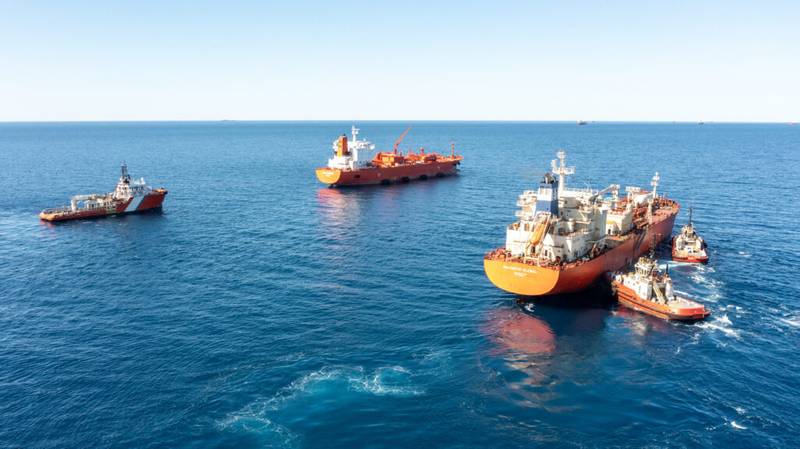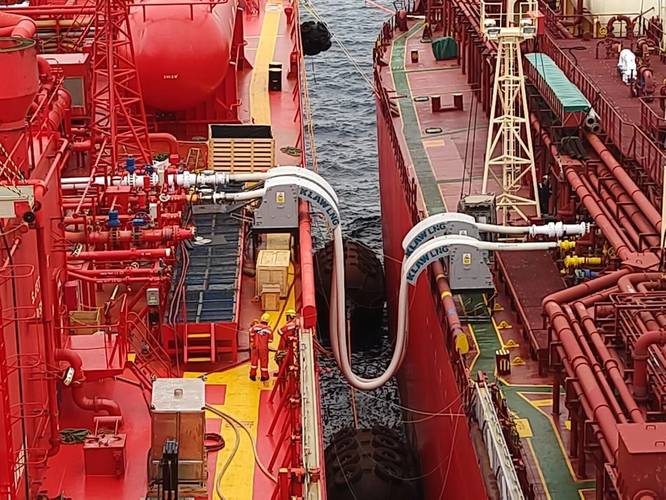GCMD-Led Partners Complete Ship-to-Ship Ammonia Transfers in Australia
A Global Centre for Maritime Decarbonisation (GCMD)-led consortium has conducted ship-to-ship transfers of ammonia at anchorages within the Port of Dampier in Australia’s Pilbara region.
Two transfers took place between the Green Pioneer, owned by Mitsui O.S.K. Lines (MOL), a 35,000 cubic meters (cbm) ammonia carrier, and the Navigator Global, owned by Navigator Gas, a 22,500 cbm ammonia carrier. Yara Clean Ammonia (YCA) provided the ammonia used in the transfers.
The first transfer involved 4,000 cbm (approximately 2,700 tonnes) of ammonia from the Green Pioneer to the Navigator Global at the Port of Dampier. The same ammonia cargo was then transferred back from the Navigator Global to the Green Pioneer.
Each transfer operation took approximately six hours, with the first transfer completed on September 14, 2024.
A tripartite collaboration between the Global Centre for Maritime Decarbonisation (GCMD), Pilbara Ports and YCA was formed to realize Pilbara’s potential as a low-greenhouse gas (GHG) emission ammonia bunkering hub.
This region was previously highlighted by a Global Maritime Forum study as a viable location for ammonia bunkering. Construction to enable renewable ammonia production by 2025 has commenced at Yara Pilbara’s facility.
The successful transfers demonstrate the operational viability of future ammonia bunkering in the Pilbara region of Western Australia, according to the partners.
The pilot also marks a step towards operationalizing a low-GHG emission shipping route for international iron ore trade, which is projected to require 1 to 1.5 million tonnes of ammonia by 2035, according to a joint 2023 study undertaken by Pilbara Ports, Yara Clean Ammonia and Lloyd’s Register.
In the absence of ammonia bunkering vessels and ammonia-fuelled ships at this stage, ship-to-ship transfers at anchorage offer the closest proxy to bunkering operations when it replicates the essential steps involved.
With this objective in mind, the trial began with a transfer at the Port of Dampier as a proxy to breakbulk, leveraging the port’s experience with ammonia export. The second transfer demonstrated the potential of bunkering operations, extendable also to other ports nearby, where such future operations for bulk carriers are expected to take place.
To operationalize this pair of transfers, the consortium built on proven procedures and incorporated additional safety mitigation measures.
In preparation for the next phase of GCMD’s initiative to enable ammonia as a marine fuel, GCMD will be leveraging the experience and knowledge gained from this pair of transfers to assess the feasibility of ammonia transfer elsewhere to ready other forward-looking ports for eventual ammonia bunkering.
“This ammonia transfer pilot is a testament to the deliberate collaboration and rigorous planning of all parties involved. Beyond addressing the technical and operational challenges, executing this pilot required us to navigate complex commercial landscapes, including securing vessels and managing cargo transfer, as well as uncertainties and spur-of-the-moment hiccups that arise during operations.
“We are deeply grateful to all our partners for their open exchanges and unwavering support, without which this pioneering effort would not have been possible. This pilot marks a crucial step towards readying the ecosystem for using ammonia as a marine fuel, paving the way for eventual bunkering when ammonia-fuelled vessels become available,” said Lynn Loo, CEO of GCMD.


















